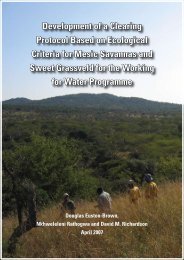Metsi Consultants - DWA Home Page
Metsi Consultants - DWA Home Page
Metsi Consultants - DWA Home Page
Create successful ePaper yourself
Turn your PDF publications into a flip-book with our unique Google optimized e-Paper software.
Report No 678-F-001<br />
METSI CONSULTANTS: SUMMARY OF MAIN FINDINGS FOR PHASE 1 DEVELOPMENT<br />
backwaters, or small floods to stimulate fish spawning, then the IFR would stipulate the magnitude,<br />
duration and frequency of the required floods.<br />
By defining water quality, physical habitat and biotic communities that characterize specific river<br />
conditions - in this manner, the IFR is linked to measurable goals that can be used to assess whether<br />
the desired river condition is being achieved.<br />
Even the most successful IFR would only partially mitigate the effects of a water-resource development as the<br />
presence of a dam would, in itself, inevitably result in downstream impacts. Application of an IFR moreover<br />
cannot guarantee a desired condition in a river since other activities in the catchment also affect river condition.<br />
For instance, even if the IFR is implemented correctly, pollution from industry or agriculture could result in<br />
changes in water quality in the river. Thus, an IFR should be established and implemented as part of a catchment<br />
management plan that has as part of its objectives the maintenance of the desired condition of the river.<br />
2.3. METHOD DEVELOPMENT<br />
Methods for determining an IFR for regulated rivers and streams have been in use in North America for the past<br />
50 years and have been used increasingly in South Africa for the past two decades. Earlier methods used<br />
elsewhere, applied statistical analyses of historic hydrological data to determine minimum flows for fisheries or<br />
other specified ecological features. Subsequent methods placed emphasis on hydraulic rating assessments.<br />
Habitat simulation as a way to establish IFRs is in widespread use in some countries, has been used to a limited<br />
extent in South Africa, and is best represented by the instream flow incremental method (IFIM) and its many<br />
derivatives.<br />
More holistic approaches to determining IFRs have been advocated in Australia and South Africa, typified by the<br />
development of the Holistic Approach in the former country and the Building Block Methodology (BBM) in the<br />
latter. These methods consider various types of flow and relate them to biophysical conditions in the river under<br />
study. Full descriptions of these methodologies are provided in the LHDA 648 reports (e.g., Report No. 648-02).<br />
In consultation with the LHDA and the Panel of Environmental Experts, the Consultant decided that an holistic<br />
approach to the LHWP IFR was justified, and the method applied should:<br />
allow the flow requirements to be assessed for all major components of the riverine ecosystem (e.g.,<br />
riparian vegetation; channel form);<br />
assess the flow requirements for several rivers;<br />
address both water quality and quantity requirements for the rivers;<br />
allow several potential flow regimes to be described, each with its predicted consequences (i.e., a<br />
scenario-based approach);<br />
incorporate a comprehensive and structured socio-economic component.<br />
The initial approach used in the study is based on the BBM. However, to meet the specific requirements of the<br />
study area and the biophysical conditions and constraints, a new approach was developed during the study and<br />
is termed DRIFT (Downstream Response to Imposed Flow Transformations). Using the present-day flow regime<br />
of the river as a starting point, this is used to:<br />
carry out a preliminary characterization of the rivers and select eight representative IFR sites on the<br />
basis of geomorphology, proximity to gauging stations and general accessibility;<br />
describe the various biophysical consequences for the river of further reducing (or, if relevant, of<br />
increasing) the flow in a number of different ways;<br />
create a database of these biophysical consequences, each linked to its flow reduction details;<br />
8

















